Bradshaw Gass & Hope
Bradshaw Gass & Hope is an English firm of architects founded in 1862 by Jonas James Bradshaw (1837–1912). The style "Bradshaw Gass & Hope" was adopted after J. J. Bradshaw's death and referred to the remaining partners John Bradshaw Gass and Arthur John Hope.
History
Bradshaw, Gass and Hope is Bolton's oldest architectural practice. It was founded by Jonas James Bradshaw who opened an office in Nelson Square in 1862 and moved to 19, Silverwell Street in 1871. His nephew John Bradshaw Gass joined the company in 1882 and Arthur John Hope was articled to the firm in 1892 before becoming a partner in 1902.[1] The firm's principal office is in Bolton, but branch offices were set up in Edinburgh and London when major projects were undertaken.
Although Bradshaw was capable of designing fine Gothic Revival houses, like Watermillock (1880–86) near Bolton, he mainly produced industrial buildings. The technical challenges of early iron and concrete framed factories led Bradshaw to employ engineers and quantity surveyors and thus founded one of the first multidisciplinary practices. The emphasis on engineering in the practice seems to have benefited John Parkinson (1861–1935), Bradshaw's apprentice from 1877 to 1882, who immigrated to America where he designed a number of high-rise buildings including Los Angeles City Hall (1928).
In the early twentieth century, Bradshaw Gass & Hope gained national prominence after winning a number of architectural competitions; the firm built seven town halls between 1928 and 1939 and extended Bolton Town Hall. During this period, Bradshaw Gass & Hope attracted many architecture students; half a dozen of these students would later head council architects departments across the country.[2]
Until the 1960s most of the firm's work was in the Classical idiom.
Sir George Grenfell-Baines, the founder of Building Design Partnership, worked in the Bolton office from 1930 to 1934; he was impressed by the firm's multidisciplinary nature but dismayed by its strict hierarchical structure (at that time).[3]
Bradshaw Gass & Hope operates from its Bolton office. In 2007 it was the subject of a monograph and its archive drawings were exhibited in London and Manchester.[4]
Selected buildings by Bradshaw Gass & Hope
Listed by date under practice title at the time:[5][6][7][4]
Jonas James Bradshaw with Leigh Hall
- Eaves Lane Workhouse (now Hospital), Chorley (1869–72)
J. J. Bradshaw
Bradshaw & Gass
- Mather Lane Mill, Leigh (1882)[8]
- Rutland Mills, Adelaide Street, Bolton (1883–1920)
- Lincoln Mill, Washington Street, Bolton (1883–1920)
- Bolton Evening News offices (1890–1907)
- The Victoria Hall, Bolton (1898–1900)
- College of Art, Hilden Street, Bolton (1901–3)
- Leysian Mission (now Imperial Hall), City Road, London (1901-6)
- Grand Central Hall, Liverpool (1905)
Bradshaw, Gass & Hope
From 1902 until 1912, the practice included the comma in its name.
- Leysian Wesleyan Mission, Finsbury (1902–4)
- Manchester Stock Exchange (1904–06)
- Atherton Library, York Street, Atherton (1904–5) (Carnegie)
- Baptist Church, Market Street, Farnworth (1906)
- Tollard Royal Hotel, Southampton Row, London (1907)
- Queen's Hall Methodist Mission, Market Street, Wigan (1907–8)
- Croal Mill, Callis Road, Bolton (1908)
- Astley Bridge Branch Library, Bolton (1909–12) (Carnegie)
- Farnworth Town Hall and Library(1909-11) (Carnegie)
- Great Lever Branch Library (1909–12) (Carnegie)
- Stockport Central Library (1912–13) (Carnegie)
- Leigh Spinners otherwise known as Leigh Mill, Leigh (1913)[9]
Bradshaw Gass & Hope
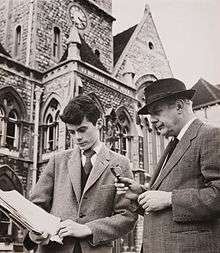
- Miners Hall, Bolton (1913–14)
- Royal Exchange, Manchester (1914–21)
- Workshops for the Blind, Marsden Road, Bolton (1914)
- Methodist College, Medak, India (1917–25)
- Sir John Holden's Mill, Blackburn Road, Astley Bridge, Bolton (1920–27)
- Miners' Convalescent Home, Promenade, Blackpool (1925–27)
- UMIST, Manchester (1927–57)
- War Memorial, Bolton (1928)
- Co-Op, Victoria Square, Bolton (1928)
- Lewisham Town Hall (1928–32)
- Leith Town Hall and Library (1929–31)
- Bolton Town Hall extensions and Civic Centre (1930–39)[10][11]
- Wimbledon Town Hall (1931)
- Trafford Town Hall (1932–33)
- Boothstown Mines Rescue Station 1933
- Luton Town Hall (1934–38)
- Chesterfield Town Hall (1937–38)
- Padiham Town Hall (1938)
- Turton High School, Bromley Cross (1939–53)
- Completion of Bolton School (1945–65)
- Police Station and Magistrates Court, Burnley (1951–55)
- Police Headquarters, Salford (1958)
- Methodist Chapel, Halliwell, Bolton (1959)
- ICI-Alkali Division Headquarters, Winnington, Northwich (1959–60)
- Girls School, Broughton, Lancashire (1962)
- Municipal Offices in Newcastle-under-Lyme (1963)
- Offices for Jeyes, Thetford, Norfolk (1970)
- Bolton Arena (1999–2001)
Image galleries
Image gallery of Buildings by Bradshaw & Gass
 Victoria Hall, Bolton (1898–1900)
Victoria Hall, Bolton (1898–1900)
Image gallery of Buildings by Bradshaw, Gass & Hope
 Farnworth Library (1909-1911)
Farnworth Library (1909-1911)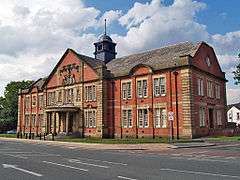 Farnworth Town Hall (1909-1911)
Farnworth Town Hall (1909-1911)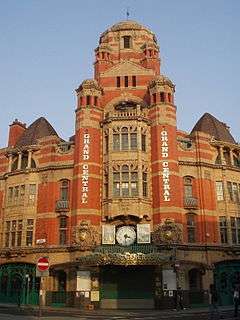 Grand Central Hall, Liverpool (1905)
Grand Central Hall, Liverpool (1905) Stockport Central Library (1912–13)
Stockport Central Library (1912–13)
Image gallery of Buildings by Bradshaw Gass & Hope
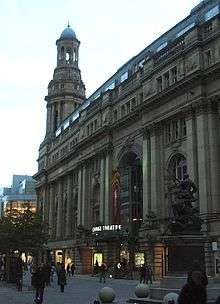 Manchester Royal Exchange (1914–21)
Manchester Royal Exchange (1914–21)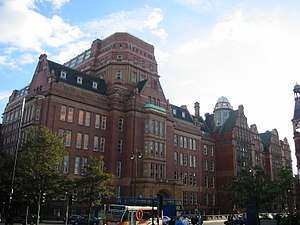 UMIST (1927–57)
UMIST (1927–57)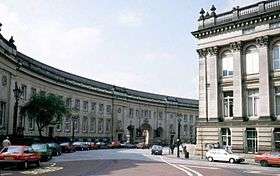 Bolton Civic Centre (1930–39) with Town Hall Extension (1937) to the right.
Bolton Civic Centre (1930–39) with Town Hall Extension (1937) to the right.- Lewisham town Hall now Broadway Theatre (1928–32)
 Trafford Town Hall (1932–33)
Trafford Town Hall (1932–33)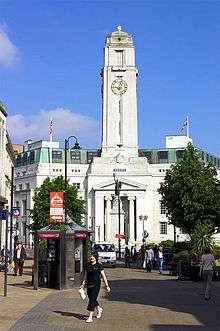 Luton Town Hall (1934–38)
Luton Town Hall (1934–38)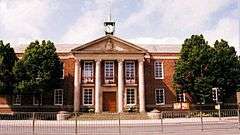 Padiham Town Hall (1938)
Padiham Town Hall (1938) Burnley Police Station and Magistrates Court (1951–55)
Burnley Police Station and Magistrates Court (1951–55)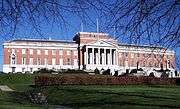 Chesterfield Town Hall (1935–38)
Chesterfield Town Hall (1935–38)
Some notable people who worked for Bradshaw Gass & Hope
Partners
- John Jonas Bradshaw (c. 1837–1912)
- John Bradshaw Gass (1855–1939)
- Arthur John Hope (1875–1969)
- James Robert Adamson (1883–1943)
- Robert Mackison McNaught (1898–1969)
Former pupils and technical staff
- James William Wallace (1850–1926) friend of Walt Whitman
- John Parkinson (1861–1935) founder of Parkinson & Son
- Professor Sir George Grenfell-Baines (1908–2003) founder of Building Design Partnership
- George Wilde became Warrington Borough Architect
- Edgar Taberner became Chester City Architect
- Albert Victor Whitworth became Exeter City Architect
- Robert Shaw became Hampshire Deputy County Architect
- Alexander Steele (1906–80) became Edinburgh City Architect
- John Bidder Clerk of Works, 1959–84
Notes
- Bradshaw, Gass and Hope of Bolton, Architects, The National Archives, retrieved 9 November 2014
- Austen Redman (2007), Bolton Civic Centre and the Classical Revival Style of Bradshaw Gass & Hope. in Clare Hartwell & Terry Wyke(editors), Making Manchester& Cheshire Antiquarian Society, ISBN 978-0-900942-01-3
- George Grenfell-Baines (2000), interviewed by Louise Brodie at Preston, (January 5–11) Architects' Lives, London: National Biographical Archive, C467/46/F7839.
- Jane & Timothy Lingard (2007) Bradshaw Gass & Hope – The Story of an Architectural Practice, ISBN 978-0-9556035-0-1
- A. Stuart Gray (1985) Edwardian Architecture: a Biographical Dictionary, ISBN 0-7156-2141-6.
- Nikolaus Pevsner (1969), Lancashire 1: the Industrial and Commercial South, The Buildings of England, ISBN 0-14-071036-1.
- Nikolaus Pevsner (1969), Lancashire 2: The Rural North, The Buildings of England, ISBN 0-300-09617-8.
- Historic England, "Mather Lane Mill (1356246)", National Heritage List for England, retrieved 9 November 2014
- Historic England, "Leigh Mill (1253119)", National Heritage List for England, retrieved 9 November 2014
- Historic England, "Town Hall (1388295)", National Heritage List for England, retrieved 9 November 2014
- Historic England, "Civic Centre (1352691)", National Heritage List for England, retrieved 9 November 2014
External links
- Bradshaw Gass & Hope Official site
- Bolton Museum & Art Gallery (based in Bolton Civic Centre)
- Friends of Trafford Town Hall – campaign to prevent demolition of Bradshaw Gass & Hope Building
- Victoria Hall, Bolton
